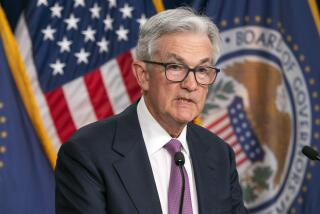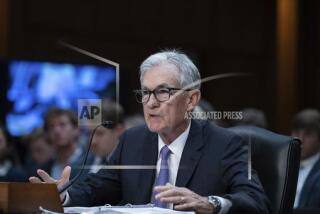Hard line on inflation adds to fears
- Share via
WASHINGTON — Federal Reserve Chairman Ben S. Bernanke’s renewed emphasis on fighting inflation over stimulating growth puts him in a tough spot, analysts say, amid fears that a worsening housing slump could bring back “stagflation”: slow economic growth paired with rising prices.
Critics say Bernanke’s hawkish anti-inflation testimony Wednesday before the congressional Joint Economic Committee shows that he’s overestimating the threat of inflation while underestimating the risks of an economic slowdown, including an implosion of the sub-prime mortgage market that could lead consumers to scale back spending.
The primary sources of inflation -- rising energy and commodity prices -- are not easily controlled by tight monetary policy, critics say. If the Fed waits too long to cut interest rates and stimulate growth, unemployment could start rising and slip beyond its control too.
By holding interest rates at current levels, as it has since August, the central bank risks recession while failing to significantly lower inflation, some analysts say.
The Fed “always focuses on inflation risks until the growth story is so blindingly obvious that it can no longer be ignored.... The longer this lasts, the bigger and quicker will be the easing,” said Ian Shepherdson, chief U.S. economist at High Frequency Economics, predicting that the Fed will cut “ very aggressively” this year when the slowing economy becomes more obvious.
Either way, the Fed is between a rock and a hard place.
“Below-potential growth and inflation running high -- what I would call stagflationlike -- has very few options in it,” said Drew Matus, senior economist at Lehman Bros. in New York. “What the Fed’s trying to do is buy time to see how the market develops.”
Former Fed Chairman Alan Greenspan said this month that the risk of recession was about 30%. Others put it closer to 40%.
On Wednesday, Bernanke acknowledged risks of a recession as the expansion enters its sixth year and growth slows from 3.4% last year to less than 2% in the first quarter, as many analysts expect. Expansions have lasted an average of six to nine years in the past, and the Fed has often waited too long to adjust rates and preempt recessions, critics say, as it did in the wake of the savings and loan crisis in the late 1980s or the dot-com bubble in the late 1990s.
Analysts arguing for rate cuts point out that business spending has slowed in recent months. A Commerce Department report Wednesday showed orders for big-ticket durable goods -- a key measure of business spending -- failed to meet expectations in February, rising 2.5%, 1 percentage point less than expected, after a 9.3% drop in January.
Inflation, however, appears to be worsening. Inflation registered 2.4% for the 12 months ended in February, and most analysts expect a Commerce Department report Friday to show a slight uptick in other inflation measures. There were signs this week that rising energy prices, which Bernanke is counting on abating, could drive inflation even higher.
In defending his emphasis on fighting inflation over stimulating the economy, Bernanke told the committee Wednesday that the economic cycle had fundamentally changed since previous slowdowns, with more moderate employment and wage growth and sustained spending enabling central bankers to extend expansions and avoid recessions altogether.
“There seems to be a sense that expansions die of old age,” Bernanke said, adding, “I don’t think that’s true.”
Bernanke believes that steady consumer and business spending could extend the expansion and counteract the housing slump as home sales and construction slow further.
Analyst Michael Englund, principal director of Action Economics in Boulder, Colo., said that expansions were “stretching and becoming less dramatic” and that Bernanke might be taking the best approach to fighting inflation, given his limited powers to counteract contractions in mortgage lending resulting from the sub-prime collapse.
Although housing downturns correlated with recessions in the past, Englund said, they didn’t cause the recessions on their own. A host of other economic indicators took a nose dive, and those indicators are looking pretty good now, including low unemployment and high consumer confidence, he said.
But some analysts say the sub-prime market’s implosion could lead to a credit crunch for already indebted consumers.
“Our whole economy has been based on consumer spending, and consumers have been spending far more than they should have,” said Peter Schiff, president of Euro Pacific Capital in Newport Beach.
molly.hennessy-[email protected]
More to Read
Inside the business of entertainment
The Wide Shot brings you news, analysis and insights on everything from streaming wars to production — and what it all means for the future.
You may occasionally receive promotional content from the Los Angeles Times.











